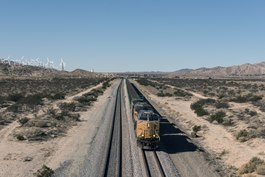
BNSF Railway is the largest freight railroad in the United States. One of six North American Class I railroads, BNSF has 36,000 employees, 33,400 miles (53,800 km) of track in 28 states, and over 8,000 locomotives. It has three transcontinental routes that provide rail connections between the western and eastern United States. BNSF trains traveled over 169 million miles in 2010, more than any other North American railroad.

The Southern Pacific was an American Class I railroad network that existed from 1865 to 1996 and operated largely in the Western United States. The system was operated by various companies under the names Southern Pacific Railroad, Southern Pacific Company and Southern Pacific Transportation Company.
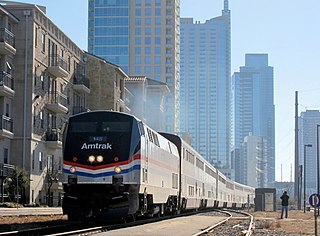
The Texas Eagle is a long-distance passenger train operated daily by Amtrak on a 1,306-mile (2,102 km) route between Chicago, Illinois, and San Antonio, Texas, with major stops in St. Louis, Little Rock, Dallas, Fort Worth, and Austin. Three days per week, the train joins the Sunset Limited in San Antonio and continues to Los Angeles via El Paso and Tucson. The combined 2,728-mile (4,390 km) route is the longest in the United States and the second-longest in the Americas, after the Canadian.
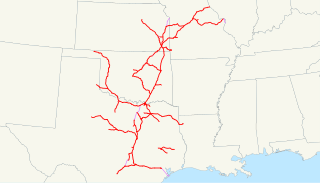
The Missouri–Kansas–Texas Railroad was a Class I railroad company in the United States, with its last headquarters in Dallas, Texas. Established in 1865 under the name Union Pacific Railroad (UP), Southern Branch, it came to serve an extensive rail network in Texas, Oklahoma, Kansas, and Missouri. In 1988, it merged with the Missouri Pacific Railroad; today, it is part of UP.
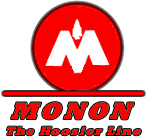
The Monon Railroad, also known as the Chicago, Indianapolis, and Louisville Railway from 1897 to 1971, was an American railroad that operated almost entirely within the state of Indiana. The Monon was merged into the Louisville and Nashville Railroad in 1971, and much of the former Monon right of way is owned today by CSX Transportation. In 1970, it operated 540 miles (870 km) of road on 792 miles (1,275 km) of track; that year it reported 1320 million ton-miles of revenue freight and zero passenger-miles.

The Missouri Pacific Railroad, commonly abbreviated as MoPac, was one of the first railroads in the United States west of the Mississippi River. MoPac was a Class I railroad growing from dozens of predecessors and mergers. In 1967, the railroad operated 9,041 miles of road and 13,318 miles of track, not including DK&S, NO&LC, T&P, and its subsidiaries C&EI and Missouri-Illinois.

The Sunset Limited is a long-distance passenger train operated by Amtrak on a 1,995-mile (3,211 km) route between New Orleans, Louisiana, and Los Angeles, California, with major stops in Houston, San Antonio, El Paso, and Tucson. Introduced in 1894 by the Southern Pacific Railroad, it is the oldest continuously operating named train in the United States.

The San Joaquin Valley Railroad is one of several short line railroad companies and is part of the Western Region Division of Genesee & Wyoming Inc. It operates over about 371 miles (597 km) of owned or leased track primarily on several lines in California's Central Valley/San Joaquin Valley around Fresno and Bakersfield. The SJVR has trackage rights over Union Pacific between Fresno, Goshen, Famoso, Bakersfield and Algoso. The SJVR also operated for the Tulare Valley Railroad (TVRR) from Calwa to Corcoran and Famoso.
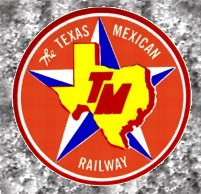
The Texas Mexican Railway was a short line railroad in the U.S. state of Texas operating between Corpus Christi and the Texas Mexican Railway International Bridge in Laredo, Texas. It is often referred to as the Tex-Mex, or TexMex Railway.
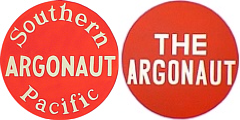
The Argonaut was the Southern Pacific Railroad's secondary passenger train between New Orleans and Los Angeles via Houston, San Antonio, and El Paso, Texas; Tucson, Arizona; and Palm Springs, California. It started in 1926 on a 61 hr 35 min schedule Los Angeles to New Orleans, five hours slower than the Sunset Limited; it was discontinued west of Houston in 1958. In earlier years it carried sleeping cars from New Orleans to Yuma that would continue to San Diego via San Diego and Arizona Eastern Railway, a SP subsidiary. Westbound trains carried sleeping cars from New Orleans and Houston to San Antonio.
The Buffalo Bayou, Brazos, and Colorado Railway, also called the Harrisburg Road or Harrisburg Railroad, was the first operating railroad in Texas. It completed its first segment of track between Harrisburg, Texas and Stafford's Point, Texas in 1853. The company established a western terminus at Alleyton, Texas prior to the Civil War. The railroad was sold after the war and reincorporated as the Galveston, Harrisburg, & San Antonio Railroad. This right of way was acquired by the Southern Pacific Railroad and is today a property of the Union Pacific Railroad.

Phoenix Union Station is a former train station at 401 South 4th Avenue in downtown Phoenix, Arizona, United States. From 1971 to 1996 it was an Amtrak station. Until 1971, it was a railroad stop for the Santa Fe and Southern Pacific Railroads. Union Station was served by Amtrak's Los Angeles–New Orleans Sunset Limited and Los Angeles–Chicago Texas Eagle. The station is on the National Register of Historic Places.

The Texas and New Orleans Railroad was a railroad in Texas and Louisiana. It operated 3,713 miles (5,975 km) of railroad in 1934; by 1961, 3,385 miles (5,448 km) remained when it merged with parent company Southern Pacific.

The Los Angeles and Salt Lake Railroad was a rail company in California, Nevada, and Utah in the United States, that completed and operated a railway line between its namesake cities, via Las Vegas, Nevada. Incorporated in Utah in 1901 as the San Pedro, Los Angeles and Salt Lake Railroad, the line was largely the brainchild of William Andrews Clark, a Montana mining baron and United States Senator. Clark enlisted the help of Utah's U.S. Senator Thomas Kearns, mining magnate and newspaper man, to ensure the success of the line through Utah. Construction of the railroad's main line was completed in 1905. Company shareholders adopted the LA&SL name in 1916. The railway was also known by its official nickname, "The Salt Lake Route", and was sometimes informally referred to as "The Clark Road". The tracks are still in use by the modern Union Pacific Railroad, as the Cima, Caliente, Sharp, and Lynndyl Subdivisions.

Ontario station is an Amtrak train station in Ontario, California, located on the Union Pacific Railroad Alhambra Subdivision. It is served by the thrice-weekly Sunset Limited/Texas Eagle. The station has a covered, open-air pavilion built by the city in 1991.

Pomona–Downtown station, is a train station in Pomona, California, United States. It is primarily served by Metrolink’s Riverside Line commuter rail service, which runs between Los Angeles Union Station in the west and Riverside–Downtown station in the east. It is also less frequently serviced by two of Amtrak's long-distance inter-city rail services, the Sunset Limited, which runs between Union Station and New Orleans, Louisiana, and the Texas Eagle, which runs between Union Station and Chicago, Illinois, via Texas. It is owned and operated by the city of Pomona.

The Southern Transcon is a main line of BNSF Railway comprising 11 subdivisions between Southern California and Chicago, Illinois. Completed in its current alignment in 1908 by the Atchison, Topeka and Santa Fe Railway, when it opened the Belen Cutoff in New Mexico and bypassed the steep grades of Raton Pass, it now serves as a mostly double-tracked intermodal corridor.
The history of the Southern Pacific ("SP") stretched from 1865 to 1998.
The Phoenix Subdivision is a railroad line in the U.S. state of Arizona owned by the Union Pacific Railroad. The southeast end of the line connects to the Gila Subdivision near Eloy, runs northeast to Phoenix, and becomes the Roll Industrial Lead, running southwest before reconnecting to the Gila Subdivision at Wellton. As of 2010, eighty miles (130 km) of the line between Roll and Arlington are out of service and used for car storage.

The Mojave Subdivision refers to a series of railway lines in California. The primary route crosses the Tehachapi Pass and features the Tehachapi Loop, connecting Bakersfield to the Mojave Desert. East of Mojave, the line splits with the Union Pacific Railroad portion continuing south to Palmdale and Colton over the Cajon Pass and the BNSF Railway owned segment running east to Barstow. Both companies generally share trackage rights across the lines.
